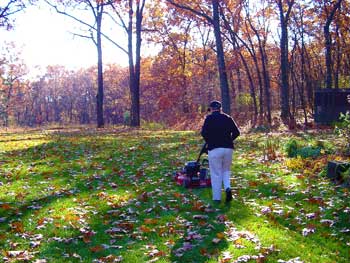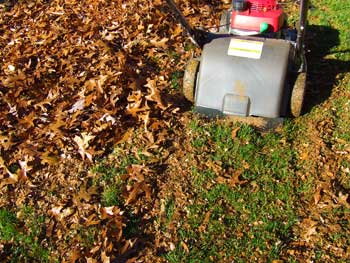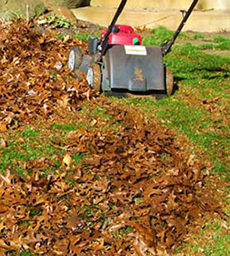
Mulch Leaves into Turf for a Smart Lawn
DOWNLOADMay 10, 2016 - Rebecca Finneran
 Turfgrass specialists from Michigan State University know that the best dressed lawns begin in fall. After a long, hot summer, you may be thinking to yourself, “Why would I want to be thinking about my lawn when I just want to go inside and forget about it?”
Turfgrass specialists from Michigan State University know that the best dressed lawns begin in fall. After a long, hot summer, you may be thinking to yourself, “Why would I want to be thinking about my lawn when I just want to go inside and forget about it?”
Over 20 years of turf research has proven that fall is the optimum time to “invest” in the green you will enjoy next spring. If fertilization is on your dance card, then you are on the right track, but don’t forget about a resource that may be staring you right in the face – tree leaves.
For years, turf managers and homeowners have been raking and bagging leaves because we all know that when leaves pile up with wet, heavy snow, it can mean disaster for the turf plant below. The ban on yard waste during the 90s prompted MSU turfgrass specialists to begin investigating how lawns would react to having ground up leaves left on the lawn and the results may surprise you!
Leaf it – and reap!
On those slightly dewy mornings during October, elevate your mower deck to the highest setting and set out on your merry way, crossing over the leaves once or twice. Usually this can occur once a week, but if there is a heavy wind, you may find yourself mowing twice in one week. There will be an obvious leaf residue on the surface of the lawn that only lasts for a few days. The tiny pieces will eventually sift down through the turf and provide future weed control and essential nutrients that can save you money and time. Come spring, you won’t even notice the tiny leaf particles.
 Up to 6 inches of leaves can be “mulched” at a time, depending on the type of mower you have. Push mowers will handle smaller amounts, but are still very effective. During the research, several years passed and turf scientists starting noticing several benefits including needing less fertilizer to achieve that spring green up. The second benefit was – what, no weeds?
Up to 6 inches of leaves can be “mulched” at a time, depending on the type of mower you have. Push mowers will handle smaller amounts, but are still very effective. During the research, several years passed and turf scientists starting noticing several benefits including needing less fertilizer to achieve that spring green up. The second benefit was – what, no weeds?
The decomposing pieces of leaves cover up bare spots between turf plants that are an excellent opening for weed seeds to germinate. Experience has shown that nearly a 100 percent decrease in dandelions and crabgrass can be attained
after adopting this practice of mulching leaves for just three years.
 Another smart tip
Another smart tip
If you have a bagging mower, you can also alternate between mulching into the turf one week and collecting the ground leaves to use as mulch in landscape beds and vegetable gardens. Covering bare soil with ground leaves prevents winter annuals from germinating and makes a great organic addition to the garden.
So if you want a recipe for a luscious lawn yet want to be “green,” put your rake away and don’t bag it!
For more information on a wide variety of smart gardening articles, or to find out about smart gardening classes and events, visit the Gardening in Michigan website.
All photos: Rebecca Finneran, MSUE



 Print
Print Email
Email





